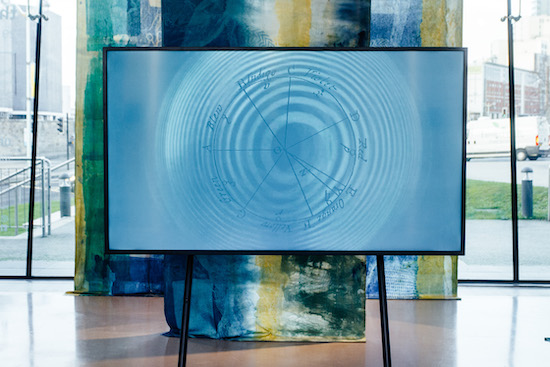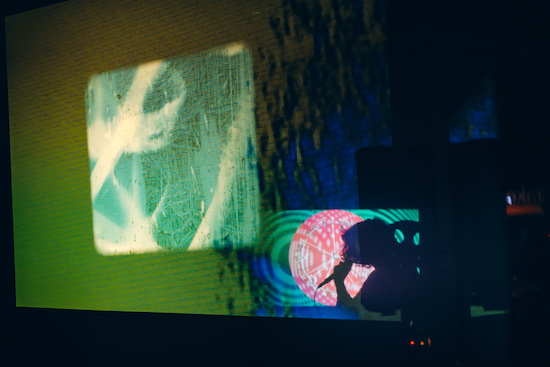Photo: Dom Moore
In the centre of Bristol, The Brunswick Club, an artist led community, has operated from an abandoned former working men’s club since January 2017. The artist residents are teetering on the brink of eviction, having staved off the evil moment for many months. Their achievements during these two years have been intense and prolific including an expansive programme of events which have taken place in the ghostly building which feels like a gently supportive squat with its stained carpets, empty bar and eerie bowling alley.
One of the major collectives operating out of the building for the past two years is Bristol Experimental and Expanded Film (BEEF), a group who encourage and facilitate sound and performance events, radical exhibitions and collective production. One of their members is Laura Phillips whose first solo exhibition owes something to the nurturing environment of this alternative anti-institution.
Being part of club culture and surrounded by experimental sound artists, her work with film, both analogue and digital has absorbed pattern, rhythm, colour and the texture and attitude of underground culture. This is apparent in the repetitive, cyclical and pulsating nature of her moving pictures. Her way of working is comfortable in the environment of the VJ and the music venue. Perhaps the unusual transition here is to witness such work in the white club of a university art gallery, especially with its links to the idea of transcendence and heightened experience through drugs and music.
Watching her films on loop in the three large plasma screens in the gallery I am reminded of the work of artist Storm de Hirsch. She was a key figure in the avant-garde film scene in New York in the 1960s and I was introduced to her work by the historian and filmmaker Laura Mulvey. She encouraged me to look at de Hirsch for her feminist credentials as a pioneer of underground cinema. I have a creased book of her poetry, Twilight Massacre (Folder Editions, 1964), on the shelf in the hall and revisited her scratched, percussive psychedelic film, Peyote (1965) via a streaming link in Laura Phillips’ lounge. De Hirsch, like Phillips, was not working on her own. She too was part of a community of makers and her approach could gain energy from conversations with the work of other artists of the counter-culture such as Stan Brakhage, Jonas Mekas and Shirley Clarke. Pioneers need friends.
Researching the history of the area surrounding the Brunswick Club, Phillips came across The Pneumatic Institute, or rather the building where the club had been based during 1799-1802. At this time the chemist Humphry Davy was studying recently identified gases including nitrous oxide and was examining its effects on itself. Nowadays the small chrome canisters are litter parts of our city pavements, detritus of nightlife and recreational drug use. The phrase, ‘I felt like the sound of a harp’, which Phillips chose as the title for her exhibition comes from an anecdote from one of Davy’s patients describing his experience under the gas’s influence.
Working in an associative and accidental methodology, Phillips bounces from this experience to images of the here and now in which participants are recorded clubbing by means of a bodycam attached to a jacket, of the functional type often worn by police and security. She has consciously chosen a mechanical eye, recording activity without the editing of a controlling human brain. The human body, rather than the directive mind, has captured these shots at the heart of the crowd. These night-vision scenes have been taken, Howard Jacques informs me, at an event at the Brunswick Club, it looks like a bobbing moment from a music night, the bodycam weaving unobtrusively and humbly through the jackets, a few spaces removed from the importance and focus of the stage.

Photo: Andy Ford
Other physical imagery recorded via celluloid and digital include balloons which bob and weave, inflate and jiggle jovially and snapping scissors, their metallic blades spinning with the fluid grace of ice-skaters. A watery smooth rhythm, concentric circles widening in a gentle psychological expansion flows through the three screens of the exhibition arranged around a round space where the viewer moves, rotating between the screens.
Hanging from the ceiling are many cloths, dyed and printed in a variety of processes, chemographs dying putting colour deep inside the fabric, eschewing pattern that sits on the surface of the cloth alone. Each cloth is about a metre wide and reaches to the floor, surrounding the viewer alongside the three screens, working on the geometry of a henge. There is something pagan, witchlike about this geometry, echoes of the apparently homogenous culture of the island’s stone age, the stone circles. This arrangement is appropriate for the ancient landscape of Plymouth’s environs. The choice of a venomous green and bilious yellow colour scheme, with the prussian blue of the cyanotype suggest a mildly dystopian state, introverted and twisted, trapping the viewer in their own mental loop.
Viridian provide a performative soundtrack for the opening which covers the oral history and sound art score which is usually circling as part of Phillips’s film art. The soundscapes gushed out by the live looping pedals seems to have informed the aesthetic of Phillips’s art and in the sound of the band. The performers tonight are one down due to the absence of cellist Liz Muir. Scraping, splashing, laughing, crashing and sawing are Dali De Saint Paul on vocals, Caitlin Alais Callahan on double bass, Esme Betamax on percussion and Phillips on 16mm films & sound responsive digital projections and more recently on a waterphone. The waterphone is a characteristically individual instrument made from camping equipment and welded rods, and its sound and use recalls to me Sylvia Hallett, a musician known for her virtuoso playing of a bicycle wheel. Phillips is a naive instrumentalist, her own virtuosity is in multi-tasking, in the immersed co-ordination skills of a VJ.
Phillips’ approach is consistent with, as it appears to me, her personality. Informed, interested, keen, hard-working, observational, thorough and humble. She does not take the centre as an extrovert grabbing the metaphorical mic but inserts herself covertly and without fuss into the background to observe, not like a spy, but as an eye immersing herself in the surroundings. She breaks down the barriers between human and machine, animal and the animate, cloth and celluloid, the fluid and the solid, thought and the object. I can imagine how the subject of early experiments with gas caught her imagination and stimulated her to create. Because the physical expression of her work shows how she is drawn to contemplate the different states of matter, not as a scientist or historian (although facets and aspects of both are in her work but as a mind, an eye encountering the universe, wanting to receive stimulus and return it to the viewer.
I feel that Phillips’ work sits easily with some of the early cinema artists, influenced by the exhortations of Futurism. It is no secret that art filmmakers have long looked to early cinema in multiple ways to inspire their work. Let us look at the 1917 manifesto once more, ‘A Slap in the Face of Public Taste’ and throw dominant tropes of cinema narrative out of the room. In a quieter, less macho way than Mayakovsky would ever embody, let the artists of our time go free, liquid and soft. Water is powerful and unstoppable although it may also be essential, gentle and life-giving. The river of Phillips’ casual determined expression flows on, facilitated by the generous communal spirit of a collected artist community. It is tragic that The Brunswick Club is currently facing its last days and expects no last minute reprieve.
Today is the last day to see Laura Philips, ‘I felt like the sound of a harp’ at The Gallery, Plymouth College of Art


